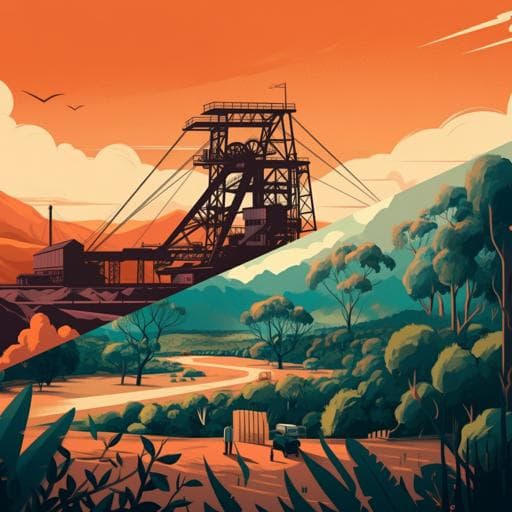
Environmental Studies and Forestry
Black coal, thin ice: the discursive legitimisation of Australian coal in the age of climate change
R. Stutzer, A. Rinscheid, et al.
This research conducted by Roman Stutzer, Adrian Rinscheid, Thiago D. Oliveira, Pedro Mendes Loureiro, Aya Kachi, and Mert Duygan delves into the discursive legitimation of Australian coal, particularly through the lens of the Adani Carmichael coal mine project. Using natural language processing, the study reveals a striking contrast between media narratives and public sentiment regarding coal and climate change from 2017-2020.
~3 min • Beginner • English
Introduction
The study addresses why and how coal-intensive pathways persist in Australia despite climate mitigation imperatives. It investigates the structures, processes, and agents that enable continued operation of coal industries, focusing on discursive legitimisation. The authors ask two specific questions: (1) whether environmental narratives in mainstream media (corporate and state-funded) differ from sentiments expressed on Twitter; and (2) whether the association between these narratives and sentiments changed over time during key public-policy decisions. Using the Adani Carmichael coal mine as a case, they compare the Courier-Mail’s coverage (as a News Corp outlet) with ABC’s and analyze public sentiment on Twitter. The broader purpose is to understand the coal industry’s social license to operate and the media’s role in shaping public discourse in the context of Australia’s political economy and carbon lock-in.
Literature Review
The paper situates Australia’s coal sector within the Regulation Approach, emphasizing accumulation regimes and modes of regulation. Coal’s structural power stems from its macroeconomic significance—averaging 17.3% of export value in the 2010s, with fuels at 28.7%—and Australia’s historic insertion as a minerals and fuel provider. Beyond structural power, the industry wields influence via inside lobbying (e.g., donations of AUSD 16.6 million to major parties, revolving doors such as Brendan Pearson’s appointment) and outside lobbying (public relations campaigns by industry bodies that target geographically and politically pivotal audiences). Pro-coal narratives (energy poverty, clean coal) and delegitimization of environmental activism contribute to hegemony-building efforts that seek a social license to operate. The media landscape, highly concentrated and significantly controlled by News Corp, functions as a potent gatekeeper, often downplaying scientific evidence and environmental concerns. Interlocking financial ties between media corporations and mining investors potentially reinforce pro-coal discourses. This background frames expectations that corporate media will align with coal interests more than public or independent outlets, and that social media may host more plural and pro-climate discourses.
Methodology
Data sources: Factiva, LexisNexis, and Twitter. The study first mapped shareholder overlaps among News Corp and major coal companies (Factiva, Dec 2019). For content analysis, articles from Courier-Mail (News Corp) and ABC were retrieved from LexisNexis, selecting all articles containing both “Adani” and “coal.” Twitter data were collected via the getoldtweets Python package, restricted to Australia using geolocation and excluding replies and retweets. Two tweet sets were compiled: (1) #StopAdani tweets (all tweets containing the hashtag, n=84,784) and (2) Adani tweets (containing “Adani” and “coal” but excluding #StopAdani, n=29,402). Words “Adani,” “coal,” and “#StopAdani” were removed to avoid artificial similarity within groups. Duplicates were removed, and standard preprocessing applied (lowercasing, removing numbers/punctuation/stop words, Porter stemming).
Text representation and similarity: Term-document matrices were TF-IDF weighted. Latent Semantic Analysis (LSA) was performed via singular value decomposition (M ≈ UkΣkVk^T), with cosine similarity used to measure document similarity. Dimensions: 200 for semantic maps (robustness with 100 and 300 yielded similar results); 50 for monthly similarity trends (robustness at 100 retained significance). Multidimensional scaling (MDS) reduced similarities to 2D for visualization. Structural break tests guided the selection of comparison periods (Mar–Oct 2017 vs Dec 2019–Feb 2020). For outlet comparison, an adjusted word count analysis was performed on 18 selected expressions spanning environmental, economic, scientific, and social-mobilization themes. Given differing corpus sizes (Courier-Mail: 961 articles; ABC: 272 articles), ABC counts were scaled by total words ratio.
Outlets: Courier-Mail represents a corporate, News Corp-owned regional newspaper in Queensland; ABC represents a state-funded online news portal. The Guardian was considered but ABC was chosen due to audience metrics. The approach leverages the pro-coal stance of Courier-Mail and anti-coal stance of #StopAdani tweets as anchors to evaluate semantic positioning and temporal shifts in Adani-related discourse on Twitter.
Key Findings
- Financial networks: Significant overlap exists between News Corp’s shareholders and major mining companies operating in Australia. Vanguard and BlackRock own 13.81% and 5.09% of News Corp respectively; both hold substantial stakes across most leading coal companies, indicating interlocking financial ties that may exert structural influence on media content.
- Media content comparison: ABC coverage contains far more environmental and scientific language (e.g., “climate,” “environment,” “science,” “concern”) relative to Courier-Mail, which emphasizes economic frames (“job,” “billion,” “economy”). Notably, “protest” and “activist” terms appear more in Courier-Mail, consistent with prior observations of delegitimizing frames against environmental movements.
- Twitter discourse dynamics: LSA-based semantic maps show that both Adani tweets and #StopAdani tweets became less similar to Courier-Mail between 2017 and 2020, while Courier-Mail’s semantic position remained stable. Monthly semantic similarity between Adani tweets and #StopAdani tweets increased steadily from March 2017 to February 2020, with a dip following the June 2019 mine approval and a peak in January 2020. The upward trend is statistically significant at 1%.
- Divergence of public sentiment from corporate media: Despite pro-coal narratives in Courier-Mail aligning with policy decisions that approved the mine, Twitter discourse moved increasingly toward anti-coal/pro-climate positions, indicating growing environmental awareness in the Twittersphere.
- Overall implication: Traditional media narratives favorable to coal appear out of step with evolving social media discourse, suggesting a shrinking capacity of News Corp channels to shape public sentiment on coal in the studied period.
Discussion
The findings address the research questions by showing a clear divergence between corporate media narratives and social media sentiment regarding the Adani Carmichael coal mine. News Corp, via Courier-Mail, functioned as a conduit for the coal industry’s outside lobbying and discursive legitimisation efforts, privileging economic frames and downplaying environmental and scientific considerations. In contrast, Twitter discourse became increasingly aligned with anti-coal positions (#StopAdani), implying rising environmental awareness and skepticism toward pro-coal narratives. However, the mine’s approval despite intensifying public contestation underscores the resilience of the state–industry symbiosis and the structural power of coal within Australia’s political economy. Thus, even as social media provides a robust arena for counter-hegemonic discourse, corporate influence through structural and institutional channels can prevail in policy outcomes. The methodological approach demonstrates how NLP and LSA can track discourse shifts and assess the proximity between media narratives and public sentiment over time.
Conclusion
The study demonstrates that Australia’s coal industry holds structural power within the national and transnational political economy and reinforces it through inside and outside lobbying, including discursive legitimisation via corporate media. Quantitative text analysis reveals that News Corp outlets maintain pro-coal narratives, while ABC and Twitter discourse emphasize environmental and scientific concerns, with Twitter becoming steadily more anti-coal over 2017–2020. This divergence suggests growing public contestation, even as policy outcomes (e.g., Adani mine approval) reflect enduring state–industry alignment and carbon lock-in. Methodologically, the paper shows that NLP tools like LSA can effectively map and compare discourses across media types.
Future research directions include: (1) expanding beyond media to analyze temporal changes in other levers of power (e.g., inside lobbying dynamics and institutional changes) to better capture shifting geometries of coal’s influence; and (2) broadening social media analysis across multiple platforms to understand how different audiences and corporate strategies evolve within and across online ecosystems.
Limitations
- Representativeness: Twitter users are not necessarily representative of the broader public. While influential, findings reflect sentiments of a politically active subset of social media users.
- Outlet comparability: ABC (state-funded, online portal) and Courier-Mail (corporate, regional newspaper) differ in format and audience; results may be sensitive to these differences. The study does not claim ABC is non-ideological.
- Causal inference: The observed association between shareholder networks and media content is suggestive of structural power, not direct causal proof of editorial influence.
- Methodological constraints: Choices of dimensions in LSA/MDS and adjustments for differing corpus sizes may affect results, though robustness checks were performed. Removal of high-frequency selection terms (Adani, coal, #StopAdani) aimed to avoid artificial similarity but also alters lexical content.
- Scope: The analysis focuses on Australia, a specific outlet pair, and a single social media platform (Twitter), limiting generalizability across contexts and platforms.
Related Publications
Explore these studies to deepen your understanding of the subject.







